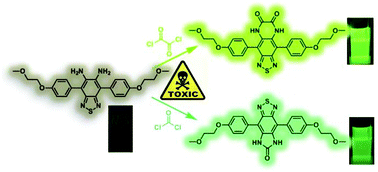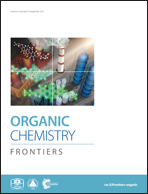A benzothiadiazole-based fluorescent sensor for selective detection of oxalyl chloride and phosgene†
Abstract
Oxalyl chloride and phosgene are highly toxic chemicals but are widely used in industrial processes, which have been regarded as a serious threat to our health and public security. Thus, it is imperative to develop a convenient and reliable detection method for these noxious agents. In this research, we report the rational design of a fluorescent sensor (denoted as BTA) for simultaneously detecting oxalyl chloride and phosgene, in which o-phenylenediamine (OPD) as the reactive recognition site and benzothiadiazole (BTD) as the fluorophore moiety are coupled into one single benzo-fused motif. The probe works in a “turn-on” fluorescence mode due to the formation of piperazine-2,3-dione and 2-imidazolidinone rings by intramolecular cyclization reactions between the OPD part with oxalyl chloride and phosgene, respectively, which greatly inhibits the intramolecular charge transfer (ICT) process from two amines to the BTD core in the sensor BTA. The detection limit of oxalyl chloride and phosgene is as low as 3 nM and 20 nM in solutions, respectively. Moreover, the sensor exhibits outstanding selectivity toward oxalyl chloride and phosgene over the nerve-agent mimic diethyl chlorophosphate and various acyl chlorides. Furthermore, a portable test paper with BTA has been facilely fabricated for visual on-site detection of the two toxic chemicals in the gas phase.

- This article is part of the themed collection: Organic Chemistry Frontiers HOT articles for 2017


 Please wait while we load your content...
Please wait while we load your content...